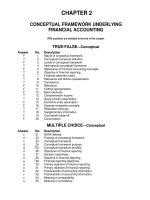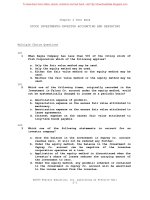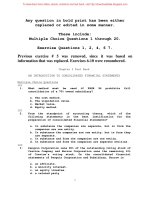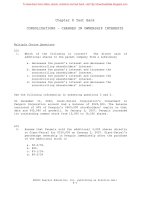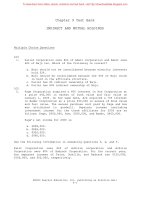Test bank international economics 10e by krugman chapter 2
Bạn đang xem bản rút gọn của tài liệu. Xem và tải ngay bản đầy đủ của tài liệu tại đây (62.97 KB, 8 trang )
International Economics, 10e (Krugman/Obstfeld/Melitz)
Chapter 2 World Trade: An Overview
2.1 Who Trades with Whom?
1) Approximately what percent of all world production of goods and services is exported to other
countries?
A) 10%
B) 30%
C) 50%
D) 100%
E) 90%
Answer: B
Page Ref: 10
Difficulty: Easy
2) The gravity model offers a logical explanation for the fact that
A) trade between Asia and the U.S. has grown faster than NAFTA trade.
B) trade in services has grown faster than trade in goods.
C) trade in manufactures has grown faster than in agricultural products.
D) Intra-European Union trade exceeds international trade by the European Union.
E) the U.S. trades more with Western Europe than it does with Canada.
Answer: D
Page Ref: 13
Difficulty: Moderate
3) The gravity model suggests that over time
A) trade between neighboring countries will increase.
B) trade between all countries will increase.
C) world trade will eventually be swallowed by a black hole.
D) trade between Earth and other planets will become important.
E) the value of trade between two countries will be proportional to the product of the two
countries' GDP.
Answer: E
Page Ref: 16
Difficulty: Moderate
4) The gravity model explains why
A) trade between Sweden and Germany exceeds that between Sweden and Spain.
B) countries with oil reserves tend to export oil.
C) capital rich countries export capital intensive products.
D) intra-industry trade is relatively more important than other forms of trade between
neighboring countries.
E) European countries rely most often on natural resources.
Answer: A
Page Ref: 11
Difficulty: Moderate
1
Copyright © 2015 Pearson Education, Inc.
5) According to the gravity model, a characteristic that tends to affect the probability of trade
existing between any two countries is
A) their cultural affinity.
B) the average weight/value of their traded goods.
C) their colonial-historical ties.
D) the distance between them.
E) the number of different product varieties produced by their industries.
Answer: D
Page Ref: 12
Difficulty: Easy
6) In general, which of the following do NOT tend to increase trade between two countries?
A) linguistic and/or cultural affinity
B) historical ties
C) larger economies
D) mutual membership in preferential trade agreements
E) the existence of well controlled borders between countries
Answer: E
Page Ref: 13
Difficulty: Easy
7) Why does the gravity model work?
A) Large economies became large because they were engaged in international trade.
B) Large economies have relatively large incomes, and hence spend more on government
promotion of trade and investment.
C) Large economies have relatively larger areas which raises the probability that a productive
activity will take place within the borders of that country.
D) Large economies tend to have large incomes and tend to spend more on imports.
E) Large economies tend to avoid trading with small economies.
Answer: D
Page Ref: 13
Difficulty: Easy
8) We see that the Netherlands, Belgium, and Ireland trade considerably more with the United
States than with many other countries.
A) This is explained by the gravity model, since these are all large countries.
B) This is explained by the gravity model, since these are all small countries.
C) This fails to be consistent with the gravity model, since these are small countries.
D) This fails to be consistent with the gravity model, since these are large countries.
E) This is explained by the gravity model, since they do not share borders.
Answer: C
Page Ref: 13
Difficulty: Easy
2
Copyright © 2015 Pearson Education, Inc.
9) The two neighbors of the United States do a lot more trade with the United States than
European economies of equal size.
A) This contradicts predictions from gravity models.
B) This is consistent with predictions from gravity models.
C) This is irrelevant to any inferences that may be drawn from gravity models.
D) This is because these neighboring countries have exceptionally large GDPs.
E) This relates to Belgium's trade record with the U.S.
Answer: B
Page Ref: 13
Difficulty: Moderate
2.2 The Changing Pattern of World Trade
1) Since the period following World War II (the early 1950s), the proportion of most countries'
production being used in some other country
A) remained constant.
B) increased.
C) decreased.
D) fluctuated widely with no clear trend.
E) increased slightly before dropping off.
Answer: B
Page Ref: 17
Difficulty: Easy
2) Since World War II, the likelihood that foreign markets would gain importance to average
exporters as a source of profits has
A) remained constant.
B) increased.
C) decreased.
D) fluctuated widely with no clear trend.
E) increased slightly before dropping off.
Answer: B
Page Ref: 17
Difficulty: Easy
3) Since World War II, the likelihood that any single item in the typical consumption basket of a
consumer in the U.S. originated outside of the U.S.
A) remained constant.
B) increased.
C) decreased.
D) fluctuated widely with no clear trend.
E) increased slightly before dropping off.
Answer: B
Page Ref: 18
Difficulty: Easy
3
Copyright © 2015 Pearson Education, Inc.
4) Since World War II, the likelihood that the job of a new college graduate will be directly or
indirectly affected by world trade
A) remained constant.
B) increased.
C) decreased.
D) fluctuated widely with no clear trend.
E) increased slightly before dropping off.
Answer: B
Page Ref: 17
Difficulty: Easy
5) Since World War II, the relative importance of raw materials, including oil, in total world trade
A) remained constant.
B) increased.
C) decreased.
D) fluctuated widely with no clear trend
E) increased slightly before dropping off.
Answer: C
Page Ref: 18-19
Difficulty: Easy
6) In the current Post-Industrial economy, international trade in services (including banking and
financial services)
A) dominates world trade.
B) does not exist.
C) is an increasingly important component of global trade.
D) is relatively stagnant.
E) far surpasses the predictions of economist Alan Blinder.
Answer: C
Page Ref: 20
Difficulty: Easy
7) In the pre-World War I period, the U.S. exported mainly
A) manufactured goods.
B) services.
C) primary products including agricultural.
D) technology intensive products.
E) weapons.
Answer: C
Page Ref: 19
Difficulty: Easy
4
Copyright © 2015 Pearson Education, Inc.
8) In the pre-World War I period, the United Kingdom exported mainly
A) manufactured goods.
B) services.
C) primary products including agricultural.
D) technology intensive products.
E) livestock.
Answer: A
Page Ref: 18
Difficulty: Easy
9) In the pre-World War I period, the United Kingdom imported mainly
A) manufactured goods.
B) services.
C) primary products including agricultural.
D) technology intensive products.
E) from the United States.
Answer: C
Page Ref: 18
Difficulty: Easy
10) In the present, most of the exports from China are
A) manufactured goods.
B) services.
C) primary products including agricultural.
D) technology intensive products.
E) overpriced by world market standards.
Answer: A
Page Ref: 19
Difficulty: Easy
11) Which of the following does NOT explain the extent of trade between Ireland and the U.S.?
A) historical ties
B) cultural Linguistic ties
C) Gravity Model
D) multinational corporations
E) large numbers of Irish-Americans
Answer: C
Page Ref: 13
Difficulty: Moderate
5
Copyright © 2015 Pearson Education, Inc.
12) When comparing the composition of world trade in the early 20th century to the early 21st
century, we find major compositional changes. These include a relative decline in trade in
agricultural and primary-products (including raw materials). How would you explain this in
terms of broad historical developments during this period?
Answer: The typical composition of world production during this period experienced major
changes. Focusing on today's Industrialized Countries (primarily members of the OECD), the
industrial-employment composition was focused primarily on agriculture. Most value was in
land. The predominant single consumption category was food. Since then, the economies shifted
from the agricultural to the manufacturing sectors (continuing trends begun over a century earlier
in the industrial revolution). Incomes rose, and consumption shifted in favor of (increasingly
affordable) manufactures. Both income and price elasticities were greater in manufactures than in
agricultural products. At the same time there was a steady tendency for synthetic (manufactured)
inputs to replace agricultural based raw materials and industrial inputs. Hence, trade and of
course international trade conformed to overall changes in patterns of world production and
consumption.
Page Ref: 17-21
Difficulty: Easy
13) In the past half century, the developing countries have experienced major compositional
shifts from exports of primary products (including agricultural and raw materials) to exports of
manufactures. How might you explain this in terms of broad historical developments during this
period?
Answer: Any discussion of the export experience of the developing countries must first clarify
the problem of definitional inclusion. In particular, the exports of the (non-OECD) developing
countries, has become increasingly dominated by the experience of a relatively small number of
countries in South-East Asia, termed the New Industrialized Countries (NICs). Since they
experienced both very rapid increases in their exports, and very rapid increases in the
manufactured component of their exports, their experience alone may explain the bulk of the
observed phenomenon. Many would exclude the NICs from the developing country category so
as to be able to focus the discussion on a more representative sample of (the over 100)
developing countries. More recently, a second wave of East Asian countries, notably including
China have replicated the experience of the NICs, and this again muddies the water for one
interested in focusing on the export experience of the increasingly heterogeneous category,
developing countries. Another explanation of the growing dependence on manufactured exports
on the part of the developing countries is the following: Since the consumer ( including
industrial consumer) markets in OECD countries were rapidly shifting away from primary
products, these markets were rapidly disappearing.
In addition, the world market for primary products was generally limited by low price and
especially income elasticities; agricultural sectors tended to be highly and rigidly protected in
potential OECD markets; and escalating effective tariff structures levied systematically large
levels of protection against the primary exports of the developing countries; export success had
to be pursued outside of the traditional primary exports of these countries.
Page Ref: 17-21
Difficulty: Difficult
6
Copyright © 2015 Pearson Education, Inc.
2.3 Do Old Rules Still Apply?
1) The Neoclassical Heckscher-Ohlin model assumes that all producers of any industrial product
has knowledge of, and may avail itself of the same production technology available to producers
in any other country. Many have flagged this identical technology assumption as unrealistic.
During the past half century, the relative importance of Multinational Corporations (MNCs) in
world trade has steadily increased. How would this trend affect the realism of the "identical
technology" assumption?
Answer: Noting that MNC plants tend to use more labor intensive production processes in
countries where labor tends to be relatively cheap (both in "low" tech, e.g., Nike, and "high
tech," e.g., Motorola), one may argue that MNCs use different technologies in developing
countries. However, this is a gross misunderstanding of the identical technology assumption. It is
axiomatically obvious that if the same MNC is producing something in both labor abundant and
labor scarce using different processes, it nevertheless has knowledge (intimate knowledge in the
case of proprietary patented processes) of available technology. The fact that the MNC may
choose not to apply the same degree of capital intensity in environments with greatly different
relative factor prices in no way lessens the fact that the Heckscher-Ohlin identical technology
assumption is strengthened due to the growing relative strength of MNCs in developing
countries. An additional fact that strengthens this argument is that, as compared to the early
1950s, a growing proportion of MNCs are themselves based in developing countries, such as
China and Brazil.
Page Ref: 21
Difficulty: Difficult
2) One of the major political developments of the past several decades is the growing size and
economic/monetary integration of the European Union. What effect do you think this will have
on international trade between countries?
Answer: The growing economic integration between the various countries of Europe, both the
old and existing members of the European Union (EU) and the new countries joining it
(including perhaps soon, Turkey), means that the barriers to trade are steadily falling in a region
that has traditionally dominated world trade. The common monetary unit should in itself go far to
promote inter-country trade within the growing EU (judging by the positive historical effect of a
single currency in the U.S.). The standardization of transportation (including railroad gauges,
highway signs etc.) and product codes will also promote expansion of intra-EU trade. The
decline in the probability of political conflict associated with this comprehensive economic
union, plus conscious attempts to cooperate in fiscal and monetary policy stances again point to
growing international trade, allowing these countries to increasingly enjoy the fruits of potential
positive scale economies, and more traditional classical and neo-classical gains from trade. The
scale economies will also tend to increase trade between the EU and other countries.
Page Ref: 21
Difficulty: Difficult
7
Copyright © 2015 Pearson Education, Inc.
3) The Services sector has been steadily rising in relative importance in GDP of the United
States, as well as elsewhere around the world. Since "services" have been identified as "nontradable" (e.g., it is difficult to export haircuts), it may be argued that this trend will likely slow
the rapid growth in international trade. Discuss.
Answer: This argument stands on questionable logical foundations. The past half century has
seen a steady growth in the absolute and relative importance of international trade. This trend has
been reversed only by global conflicts, i.e. the two World Wars. This trend has remained steady
and robust despite major compositional shifts (e.g., from primary to manufacturing), and location
shifts (e.g., the sudden rise of NICs as significant group of exporters). The trend will probably
continue into the reasonable future, fueled by both super-regional preferential trade regions and a
growing impact of the multilateral forces, represented institutionally by the World Trade
Organization (WTO)—as illustrated by the recent abolishment of the epitome cartelized trade,
the world trade in textiles. Driven by technology—especially in the areas of communication and
transportation—a reversal of the growing trade trend is not likely in the near future. In any case,
many "services" are in fact quite tradable. Examples would be financial services, long-distance
teaching, "help-desk" outsourcing, consulting and management services and others. In fact, when
a tourist gets a haircut, we see that even haircuts become a "tradable" service.
Page Ref: 17-21
Difficulty: Difficult
8
Copyright © 2015 Pearson Education, Inc.
